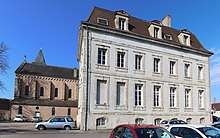Abbey of St. John the Great, Autun
Saint-Jean-le-Grand abbey of Autun, in Autun, Saône-et-Loire, France, is an abbey of Benedictine nuns, possibly founded by Queen Brunhilda and Bishop Syagrius of Autun. According to Gregory of Tours, it already existed in 589.

History
In 592, Brunehilda had the abbey of Saint-Jean d'Autun raised on the ruins of a temple near the walls dedicated to Berecyntian Cybele, mother of the gods, and endowed her with girls under the name of St. Mary. However, Gregory of Tours quotes a women's abbey at Autun in 589.[1] In 602, Pope Gregory the Great confirms the privileges granted to this abbey by letter preserved in the form of copy in Registrum Gregorii: "Monasterio sanctae Mariae, ubi ancillarum Dei is congregatio constituta, in urbe Augustodonensi a reverendae memoriae Syagrio episcopo condito "(" [...] monastery Sainte-Marie where a group of servants of God was formed, a monastery established in the city of Autun by Syagre, bishop of good memory "). This letter suggests that only the bishop is the founder of the establishment, since Brunehaut does not become queen until 593. The episcopate of Syagre begins around 5602. So between that date and 592, about thirty years that must be located the foundation of the Abbey Sainte-Marie d'Autun.
This monastery was plundered and destroyed by the Saracens in 732, then in 765 by Waiofar, Duke of Aquitaine. Charlemagne had it rebuilt and gave it the name of St. John, with that of St. Mary. In 852, it was the turn of the Normans to ravage the region. In 879, the county of Autun was annexed by King Boso of Provence to his kingdom of Provence.
From 1359 to 1364, the big companies camped under the walls of the city. At that time, the city of Autun was governed by the officers of the Chapter of abbeys: Abbey Saint-Andoche, Saint-Jean the Great, bailiff and vierg, representing the Duke of Burgundy.
Blood flowed in the city of Autun May 18, 1591 when Marshal d'Aumont invested the city at the head of the army of Henry IV.
In 1770, it was an abbey of reformed Benedictines.
The Saint-Jean district, around the Arroux gate, north of the city, seems to have been a site for making terracotta and glass. Coroplath pottery workshops, including that of Pistillus, were located following the discovery of mussels. In the whole of the city and on the site of the monasteries of Saint-Andoche and Saint-Jean-le-Grand were discovered furniture dating from the fifth century.[2]
References
- Gregory of Tours, History of the Franks, Paris, 1965, R. Latouche trad., IX, XI: "Constantinam, filiam Burgulini, in monastyrio Agustidensi relicta".
- Pietri, Picard, 1986, p. 42-43, et les notices de O. Picard et Christian Sapin, dans Pinette, 1987, p. 338-385.